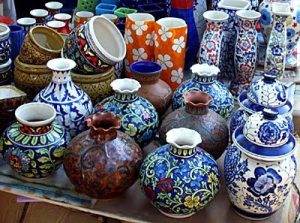By Saptakala
Clay Dexterity of Gujarat Clay, terracotta, mud are all synonymous with the earth which is the wellspring of life! Clay, the very element of earth and life takes on shapes of creativity under the dexterously nimble hands of the potter. From the earliest beginning mankind has been fascinated with the ability to mold and cast the very earth to suit his needs and bring forth his creative passion. Humankind or man has shared a primordial relationship with clay, this element was found on the banks of rivers and lakes nurturing life itself. The legacy of clay work or maatikaamkalakari is linked to that of the oldest settlements unearthed in Gujarat. Terracotta or clayware is an intrinsic craft form valued and treasured across varied communities all over the state of Gujarat. Clay is widely used as a building element, a medium for crafting fine utensils and a mode of artistic creative expression. Patterned design elements are sculpted in relief beautifying homes while the Prajapati or potter turns his wheel shaping utensils of beauty and need. Animal figurines in terracotta are ritualistically offered to gods and warriors and the same clay yields toys for toddlers. Clay has been molded, kneaded, sculpted and formed by artisans in Gujarat into utensils, totems, toys and figurines, building material and even garnered for its medicinal properties. The percussion tapping of the clay pot seller is still a familiar sound in urban residential centers today. Clay is a widely spread medium attracting diverse users ranging from architects and landscapers to home makers, children and even jewelry and hobby enthusiasts. This ecologically, vibrant, biodegradable material is a powerful religious symbol of our links with the earth and Mother Nature. Maatikaam or terracotta in the field of design sculpts itself into a serene sense of timelessness, rising out of the bowels of the earth and gives form to the creativity of mankind! Glossary of Local Terms Maati- Clay Maatikaam- Claywork Kumbhar Range of Techniques Hand Building or Coiling Technique The shaping of clay by hand using the coiling technique to make a variety of products predates molding and the usage of the wheel. Products are hand sculpted using coiling, pinching, slabbing methods. In this skill intensive technique, clay is rolled into long threads which are added in continuous spiral to form the shape of the pot. This is then pinched and beaten together to form the body. Parts of the product are joined together by a paste made of clay and water known as ‘slip’ and ‘slurry’. Hand sculpted objects in clay are one of a kind retaining their individual character. Potter’s Wheel A wheel is the obvious impression of a potter’s workshop. The potter’s wheel lends itself in shaping objects of radial symmetry on a vertical plane. A mound of clay is placed on the wheel-head and is commonly known as the throwing process. Further process of giving the mound a desired shape and hollowing it out on the rotating platter is often considered as the most difficult part. Through skill and dexterity a certain degree of mass production and uniformity of products is also possible. A wheel is the obvious impression of a potter’s workshop. The potter’s wheel lends itself in shaping objects of radial symmetry on a vertical plane. A mound of clay is placed on the wheel-head and is commonly known as the throwing process. Further process of giving the mound a desired shape and hollowing it out on the rotating platter is often considered as the most difficult part. Through skill and dexterity a certain degree of mass production and uniformity of products is also possible. Products ranging from water pots to tableware, take shape on the wheel and the revolving platter is also used to mold plates and bowls. The platter or turntable is either turned by hand or in lot of cases today is motorized. Further enhancement of the product is done by various techniques like glazing, carving, painting etc. Engobe Embellishment Engobe is a method of beautifying the surface of a clay or terracotta product by embellishing the surface before baking. The method deals with the application of a clay paste or slurry which has been stained with metal oxides to give it color. Low Relief Low relief is one of the simplest forms of ornamentation technique for clay or mud work. Clay is pinched or molded onto a variety of patterns on a flat surface. The unique quality of this art form is the shallowness of the projected image and the usage of other elements such as glass, beads etc embedded into the design. Array of Clay Dexterity in Gujarat Terracotta Ware Mud Relief Religious totems.
Courtesy: Crafts of Gujarat





